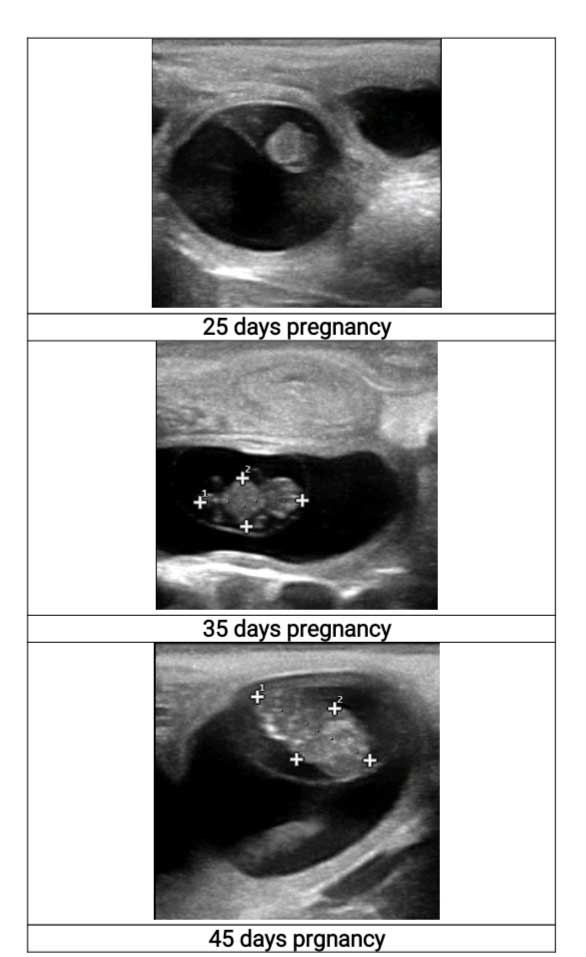Introduction
Early pregnancy diagnosis is essential to maintain the farm in a profitable manner. Timely diagnosis of the non pregnant animal by the farmer helps them to rebreed at the subsequent estrus and to maintain an optimum calving interval. After delivering a calf, dairy animal should become pregnant within 3months, so that it will remain in milk production for 10 months a year and the dairy enterprise gives back profitable returns. It is said that for a reproductively healthy farm, 85% of the total animals must be in milking and 70% should be pregnant. To achieve this target, timely pregnancy diagnosis must be done. Delaying in identifying the non pregnant animal leads to economic loss to the farmers. Hence the manuscript discusses the methods of early pregnancy diagnosis (EPD) in dairy cattle and its importance in improving the production potential, which will be the key factor to improve the economy of small / marginal farmers and large dairy enterprises too.
Importance of early pregnancy diagnosis
- EPD is crucial in shortening the calving
- It reduces the number of open
- The pregnant and non pregnant animal can be managed
- It helps to increase the productive life of the
- As pregnancy rate increases, the calving to conception interval decreases, so the animal produces more number of off-springs in its lifetime.
- It helps to identify the non pregnant animals much earlier which enables to find out the causes for non-return to cyclicity (anestrus, cystic conditions, early embryonic mortality etc.,)
- It reduces the number of culling for reproductive failure collectively this increases herd
- It also increases milk production per day of herd lifetime
- It was reported that the farmers would incur a loss of around INR 300 – 400 per day due to one day increase in open period due to delay in pregnancy diagnosis. Unnecessary loss due to poor estrus detection can be avoided.
Methods of pregnancy diagnosis
Observing the animal for returning to estrus after 21 days of breeding is the practical managemental aspect of pregnancy diagnosis. This method is referred to as ‘Non-return to estrus’. Animal not showing estrus in the next cycle can be considered as pregnant, non return to estrus occurs also in many pathological conditions like cystic degeneration, anestrus, persistent corpus luteum etc.,. It was also reported that about 7 % of the pregnant animals show estrus sign. Hence ‘non-return to estrus’ parameter cannot be an accurate method of EPD. Hence a variety of methods were designed to identify the pregnant animal in the earler stages. Direct Methods include Trans-rectal palpation and Ultrasonography, while Indirect Methods include Hormonal, Immunological and Chemical approaches
Transrectal palpation
The minimum length to identify pregnancy through rectal palpation requires at least 60 days post breeding. However experienced and skilled Veterinarians can confirm pregnancy at an early stage of 40-45 days post-breeding by the palpation of amniotic vesicle and slipping of chorioallantoic membrane between the thumb and forefinger as described by Zemjanis and Finischer Technique. Several studies have suggested that examining pregnant cows early in gestation, especially inexperienced physicians increases the risk of iatrogenic embryonic mortality.
Ultrasonography
Application of ultrasonography has made pregnancy diagnosis possible as early as 25 days post insemination. By using ultrasonography, the non pregnant animals can be identified at least 15 – 30 days earlier when compared to standard trans-rectal method of examination. Non-regressed corpus luteum (> 15 mm diameter) which could be identified by ultrasonography can be an first indicator of pregnancy, however it is not confirmatory due to various pathological conditions. The following observations are the positive signs of early pregnancy by using ultrasonography.
- Identification of fetal fluid : 18-22 day
- Identification of fetal heartbeat : 24-30 day
- Identification of fetus : 25-30 day

Veterinary grade ultrasound machine equipped with a rectal transducer are expensive in developing countries and therefore the high initial cost limits its practical implementation.
Progesterone estimation
A change in the plasma concentrations of progesterone about 19 days of post breeding plays an important role in identifying pregnancy. Conceptus extends the life span of corpus luteum by preventing the luteolytic mechanisms by the phenomenon of ‘maternal recognition’.
Estrone sulphate estimation
It is a conjugated steroid product of estrone, present predominantly in bovine placentomes and fetal fluids. Eventhough measurable concentrations of this compound are detected by day 52 post breeding, this test is reliable only after 100 days.
Early conception factor
Early pregnancy factor or Early conception factor is a protein present in sera of pregnant mammalian females detected within 6-24 hrs of fertility and disappearing within 24-48 hrs after death of embryo. Predictability of such an early test may still remain low due to high incidence of losses during 15 days of conception.
Interferon τ
It is an early secretary protein from bovine blastocyst produced between days of 14-16 in cattle. These 172 amino acid polypeptide blocks transcription of estrogen receptor alpha and oxytocin receptors in endometrial cells, while down-regulating the expression of enzymes cyclooxygenase-2 and prostaglandin F synthase, thus preventing prostaglandin release necessary for luteolysis. But no field level test available based on these markers.
Pregnancy Associated Glycoprotein
Pregnancy associated glycoproeins (PAG) are secreted by relocation of extra-embryonic trophoblastic cell layers to the endometrium between days 20- 28 and secretions from conceptus lead to successful implantation and continuation of pregnant ruminant species. PAG estimations are used as bench top pregnancy detection methods and are commercially available (Bio-PRYN: Biotracking, Russia; DG29: Genex cooperative.Inc.,USA; IDEXX: IDEXX lab Inc.,USA). The accuracy of PAG-RIA based pregnancy diagnosis as early as day 31 is possible with 100% sensitivity and 90-100 % specificity.
Apart from these tests, estimation of various hormonal metabolites in urine and cervical mucus viz., barium chloride test, Sodium hydroxide test, specific gravity test, seed bio-assay test have been designed for diagnosis of pregnancy with variable accuracy under laboratory conditions.
On perusing the various technologies, Ultrasonography and estimation of PAGs are found to be highly reliable for EPD in dairy cattle.
Current scenario in Indian field conditions
Most of the dairy animals in our country have been owned by marginal farmers and women. Trans-rectal palpation is the cheapest and the widely used method in our country to diagnose pregnancy in dairy cattle. However, application of reproductive ultrasonography has the potential to be implemented in the field conditions, when considering its advantages over precise diagnosis. In the current scenario, ultrasonographic equipments are confined only in district headquarters and educational institutions. In addition, lack of skilful practitioners poses difficulty in implementing the technology. Initiative should be taken by the policy makers and the scientific community to popularize the technology by conducting skill development programmes.
Conclusion
An early and precise diagnosis of pregnancy is important for better reproductive management in dairy enterprise. Delay in identifying the non pregnant animal leads to economic loss to the farmers. Under Indian conditions, identifying pregnancy by trans-rectal examination as early as 45 days is the cheapest method of EPD. New challenges in bovine breeding systems warranted introduction of new user-friendly technologies. Ultrasonograhy and PAG estimation were found to be potent alternate technologies in the field. Adapting new methods, especially portable ultrasound machines which are now become cheap and affordable may prevent such loss for the marginal farmers in our country. Strengthening the diagnostic facilities (like portable ultrasound machines) and basic infrastructure in veterinary clinics is the important development measure to be taken by animal husbandry department for improving the diagnostic skills. Making the best use of new scientific innovations in veterinary field will provide a long-awaited breakthrough in EPD.






1 Trackback / Pingback